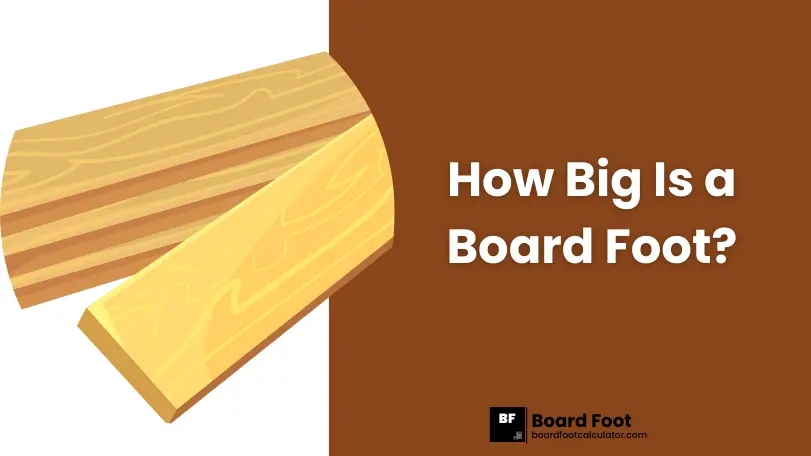When working with lumber, a board foot is equivalent to 144 cubic inches. To calculate it, multiply the thickness, width, and length of the wood piece, then divide the total by 144. This measurement helps estimate the amount of wood needed accurately. Understanding board feet is essential for buying the right amount of lumber for your projects. If you want to know more about board feet and its practical applications, keep exploring the details provided in this research.
Main Points
- A board foot is 144 cubic inches of lumber.
- Determined by multiplying thickness, width, and length.
- Calculation: (Thickness x Width x Length) / 144.
- Crucial for accurate wood quantity estimation.
- Helps in purchasing the right amount of lumber.
How Big Is a Board Foot (Detailed)

Understanding the Basics of Board Feet
To grasp the concept of board feet, think of it as a unit of measurement specifically used for lumber. Fundamentally, a board foot is a measurement of volume equal to 144 cubic inches.
This measurement is vital in the lumber industry as it helps determine the quantity of wood in a piece. When calculating board feet, you consider the thickness, width, and length of the lumber. For instance, a board that’s 1 inch thick, 12 inches wide, and 12 inches long equals one board foot.
Understanding this basic concept is fundamental when working with lumber, as it allows you to accurately estimate the amount of wood needed for a project. Whether you’re a professional carpenter or a hobbyist woodworker, knowing how to calculate and work with board feet will streamline your projects and help you make informed decisions when purchasing lumber.
Calculating Board Feet: The Formula
Understanding the formula for calculating board feet is essential for accurately estimating the amount of lumber needed for your woodworking projects. To calculate board feet, you multiply the thickness (in inches) by the width (in inches) by the length (in feet) of the lumber. Then, divide the total by 144 to get the board feet measurement. The formula can be represented as: Board Feet = (Thickness x Width x Length) / 144.
For example, if you have a piece of lumber that’s 2 inches thick, 6 inches wide, and 8 feet long, the calculation would be as follows: Board Feet = (2 x 6 x 8) / 144 = 8 board feet. Remember, board feet represent a volume measurement, so it’s crucial to use the correct units and convert measurements accordingly.
If you’re looking to calculate board feet for your projects, explore our board foot calculator on the homepage for precise measurements and planning.
Real-World Examples of Board Feet
When working on woodworking projects, understanding how to calculate board feet using the formula is key, and applying this knowledge to real-world examples can provide valuable insights. For example, let’s say you’re planning to build a bookshelf that requires 20 pieces of wood, each 2 inches thick, 6 inches wide, and 8 feet long. To calculate the total board feet needed, you’d first convert all the measurements to the same unit (in this case, feet).
Next, you’d multiply the thickness (2 inches = 0.167 feet), width (6 inches = 0.5 feet), and length (8 feet) together for each piece of wood to get the volume in cubic feet. Then, you’d sum up the volumes of all 20 pieces to find the total board feet required for the project.
This real-world example demonstrates how knowing how to calculate board feet can help you accurately estimate the amount of lumber needed for your woodworking projects, ensuring you purchase the right amount and minimize waste.
Board Foot Vs. Linear Foot: Key Differences
Compare the board foot measurement with the linear foot measurement to understand their key differences easily. When working with wood, knowing the distinction between board feet and linear feet is essential for accurate measurements and cost estimation.
- Board Foot: Represents a volume measurement of wood, considering thickness, width, and length to calculate total board feet.
- Linear Foot: Refers to the length measurement in a straight line, commonly used for items like trim, baseboards, or moldings.
- Usage: Board feet are ideal for determining the total amount of wood needed for a project, while linear feet are more suitable for measuring the length of a specific piece.
Understanding these differences will help you make precise calculations and purchases when working on woodworking projects. By grasping the unique aspects of board feet and linear feet, you can effectively plan your materials and avoid unnecessary waste or shortages.
Practical Applications of Board Feet
To determine the amount of wood required for a project accurately, consider utilizing board feet measurements. When planning your woodworking projects, understanding board feet can help you estimate the amount of lumber needed more efficiently. Below is a table demonstrating how board feet can be applied practically:
| Project Type | Board Feet Calculation |
|---|---|
| Bookshelf | Measure length, width, and thickness of each board. Sum up the total volume in board feet. |
| Dining Table | Determine the surface area of the table. Convert to board feet using thickness. |
| Deck Construction | Calculate the square footage of the deck. Convert to board feet based on the desired thickness. |
| Cabinet Making | Measure the dimensions of each cabinet piece. Calculate total board feet required. |
Conclusion: How Big Is a Board Foot?
Now that you understand how to calculate board feet and the difference between board feet and linear feet, you can confidently tackle woodworking projects with precision.
Remember, a board foot is a standard measurement used in the lumber industry to determine the volume of wood in a board. By utilizing the formula and examples provided, you can efficiently estimate the amount of lumber needed for your next project.
Keep practicing and soon you’ll be a pro at working with board feet.
